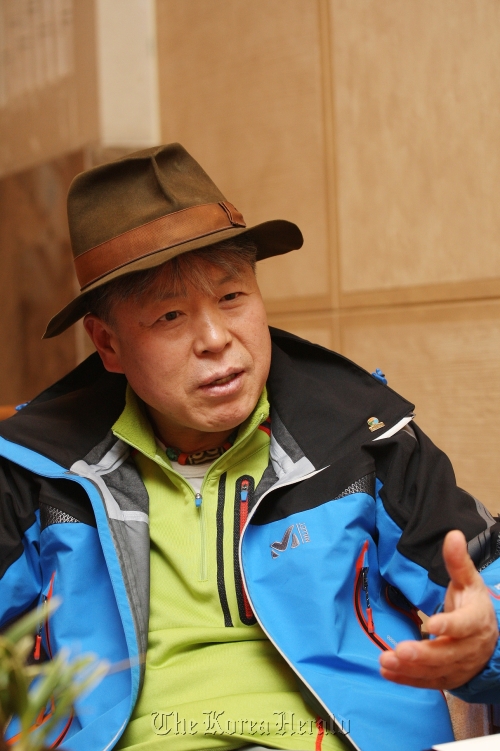SEOGWIPO, Jeju ― Korea’s foremost mountaineer Um Hong-gil is scaling his 17th summit. The first person to have stood atop the 16 highest points on Earth, including all 14 8,000-meter peaks in the Himalayas, has now taken on the challenge of building schools in remote villages in the Himalayas.
“At some point in the process of mastering the 16 peaks, I resolved to return the ‘favor’ given to me by the Himalayas if I survived the climb. I prayed, ‘Please let me live and return,’” Um told The Korea Herald on Saturday at Hotel Lotte on Jeju Island, before leading a group of 52 people in climbing the snow-covered Mount Halla the following morning.
“At some point in the process of mastering the 16 peaks, I resolved to return the ‘favor’ given to me by the Himalayas if I survived the climb. I prayed, ‘Please let me live and return,’” Um told The Korea Herald on Saturday at Hotel Lotte on Jeju Island, before leading a group of 52 people in climbing the snow-covered Mount Halla the following morning.

Hotel Lotte, which organized the special program, is donating part of the proceeds from the package program, about 5 million won ($4,400), to Um Hong Gil Human Foundation, where Um serves as the general director.
“It was now time to keep my promise with the Himalayas,” said Um of his foundation which he established in May 28, 2008.
Over the years of repeated trips to the Himalayas, Um’s eyes opened to the reality of the lives of the people of the Himalayas.
“I saw the children caught in the vicious cycle of poverty of their parents and I wanted to give them an opportunity to work and to have hope,” said Um.
Thinking about how he can keep his promise to himself and the Himalayan mountain gods, Um decided to build schools. He shared his vision with his acquaintances who willingly joined in the project. Among his many corporate and individual supporters is Millet, an outdoors wear company where he serves as the chief public relations officer.
The foundation so far has opened two schools. On Feb. 20, the construction of the third school near the Nepal-India border will be completed. This will be followed by a ground-breaking ceremony at the site of the fourth proposed school.
“The first school, opened in 2010, is the highest-altitude school in the world. Located some 4,060 meters above sea level in Pangboche, Nepal, it serves 45 elementary school students,” said Um. The school has a special place in Um’s heart. It is located in the hometown of the Sherpa who was killed on the slope while guiding Um on his second attempt at Mount Everest in 1986.
Talking about the schools, Um’s eyes twinkle and his voice brightens. “It costs about 200 million to 300 million to build a school. While school buildings built by other NGOs and charities tend to be plain, stereotypical buildings, the designs of our schools take into consideration the particular requirements of the locale where they are being built, paying particular attention to the weather conditions,” he explained. For example, the school in Pangboche, where it is very windy and the winters are long and extremely cold, is very well insulated. The remote village lacked health services so Um added a health post staffed with a local nurse.
The foundation also plans to send well-performing graduates to high schools in Kathmandu, providing them with financial support.
“I never imagined I would complete climbing all of the 14 peaks in the Himalayas. Climbing the 6th, 14 seemed impossible. I told myself, ‘Let’s just do two more,’ and then I just kept at it. I liked the Himalayas and my confidence grew. It was also a goal,” Um explained.
The importance of having respect for nature, keeping a mental equilibrium, and humility are some of the lessons he learnt on the snow capped slopes as he walked the fine line between life and death. And they are values that he wants to share with his fellow climbers.
Um has led many lay people in trekking expeditions. But he has not had anyone drop out during a climb, not even when he led a team of disabled climbers.
“People say it is arduous, that they are exhausted. But they ultimately complete the climb,” Um said.
On Sunday, all 52 climbers, ranging in age from 11 to 64, completed the five-hour Mount Halla expedition.
By Kim Hoo-ran (khooran@heraldcorp.com)
-
Articles by Korea Herald


![[Grace Kao] American racism against Stray Kids](http://res.heraldm.com/phpwas/restmb_idxmake.php?idx=644&simg=/content/image/2024/05/13/20240513050827_0.jpg&u=)





![[KH Explains] Naver’s Line dilemma: Lose global footing for cash?](http://res.heraldm.com/phpwas/restmb_idxmake.php?idx=644&simg=/content/image/2024/05/14/20240514050624_0.jpg&u=)

![[Herald Interview] Carbon breakthrough in Korea: Making diamonds at atmospheric pressure](http://res.heraldm.com/phpwas/restmb_idxmake.php?idx=644&simg=/content/image/2024/05/14/20240514050559_0.jpg&u=20240514184059)








